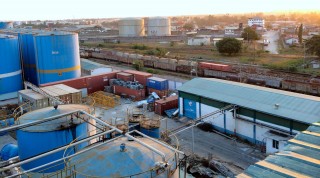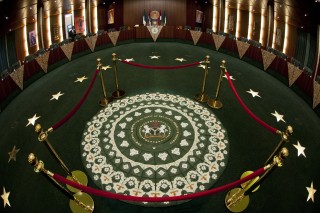I remember the first time I saw someone hawk a framed painting in traffic. If that sounds strange to you, well, I only have one explanation — I live in Lagos, Nigeria. No matter how hard I tried to justify it, it looked out of place in that setting. I had seen artists spend hours and days creating a piece. So why would the product of so much hard work and creativity end up in the same marketplace with sausage rolls and soft drinks? Not every artist will paint Africa’s Mona Lisa, but every artist needs an audience. And I do not think the roadside is the marketplace for art. However, the difficulty in getting a market makes the option less unimaginable.
Changing the narrative
The art value chain is somewhat complex; it consists of a primary and secondary market. The primary market comprises the artists either commissioned by a centre or freelancers. Also in the primary market are public and private-owned art businesses such as galleries and cultural centres. Then finally, customers – tourists, private collectors or even institutions.
In the secondary market, you have customers who choose to sell off art acquired in the primary market to auction houses, collectors and other institutions like museums. With this web of external parties, an inexperienced curator cannot sell or buy art. And if you don’t own a gallery, you cannot host exhibitions. As an artist, if you haven’t made any solid contacts to push your work, your chances get slimmer with each hurdle. The industry has been long due for a makeover, so it makes sense that technology is changing the narrative.
Last year, there was quite a buzz about the metaverse, especially after Facebook rebranded to Meta. But what is the fuss about? Why are artists so excited about this disruption?
Kevin Kamau, a Nairobi-based artist, started digital arts in 2016. He wasn’t profiting, but it was a great way to express himself. His art took a new turn at the end of 2020 when he discovered NFTs. “I heard of NFTs in December 2020. At the time, CryptoPunks, Cool Cats and Beeple were selling NFTs for millions of dollars. And here, we were just making digital arts for the fun of it. So I decided to hop on the train.”

Not only did Kevin begin to make life-changing profits, but he also discovered a new community. “I got into NFTs actively when a collector from Twitter sent me $100 to mint my first NFT on OpenSea. After a month, I started selling. It turned out people liked the art that I made. It has been life-changing for me. I now sell my artworks for hundreds of dollars — I barely used to make any money from them before.” Many African artists today are like Kevin. They struggled to get an audience that appreciated their work — or even understood it. But now, the NFT space gives them access to a bigger market that includes people who value their art.
So what are NFTs?
Put simply, NFTs are considered digital art (music, visual art, poems, etc.) or any asset in the virtual world that can be tied to a blockchain and sold using cryptocurrency. But if it’s that simple, what’s with the name? Why are they called non-fungible tokens and not just crypto art or crypto-assets (we call them those, too)? Well, maybe that would make sense when we explain what NFT means.
To understand the term “non-fungible”, you need to know what “fungible” means. “Fungible” implies that you can replace it with another of the same kind. That means your N500 or $1 bill is fungible since you can exchange them for identical bills and not lose anything. Cryptocurrencies are also fungible — you can exchange one bitcoin for another without losing any value.
A non-fungible token is the opposite of this. No two NFTs can be the same because when an NFT is minted onto a blockchain, a unique token ID is created and linked. So it makes sense to associate them with art as no two tokens have the same value. Art is also regarded as one of a kind—no two paintings are the same.
Again, NFTs can be anything digital (music, a poem, or even a game character), but a lot of the current excitement is around using the technology to sell digital art. These digital arts can be images, videos or GIFs. For artists, NFTs also give them the chance to earn a percentage every time their art is sold or changes hands, even after they have transferred ownership. This way, if their work gets super popular and balloons in value, they won’t be left out of that benefit.
A market for Africans
According to a report by Reuters, NFT sales rose to $10.7 billion in the third quarter of 2021. Statista shows that NFT sale volumes in the art sector grew from 12,085 in May to 94,523 in September. Some of the reasons for this disruption in preference are the speed and convenience of transactions in the blockchain. But more importantly, NFTs simplify the market for artists and collectors.
Traditionally, for local artists to get rewarded for their art, they need to get it into a gallery and sell on commission. If the curators don’t like their work, it won’t be accepted. NFTs disrupt this by opening the market to everyone. Through decentralised blockchain networks, artists and collectors now meet without the need for a middleman.
Culture on blockchain
There is a lot of hype about how much money artists and collectors are making from NFT sales. But that’s only a part of the story. African artists now have a place to display their rich culture and tell their stories to the world using NFTs. It was a good way for Kevin to celebrate his national heroes — especially the ones he connected with.
“Dedan Kemathi was a freedom fighter against the British colonial regime, and my grandfather was part of that movement. He wasn’t in the army, but he helped people find shelter in forests. He told me many stories about those times, and I saw blockchain as an opportunity to also tell that story to a wider audience,” said Kevin.

Chuma Anagbado is very expressive about his culture. He believes the Igbos from Nigeria need more representation as they are not understood well enough. Among other channels, Chuma uses his art to promote the Igbo culture. “My work essentially is about promoting the Igbo culture. We have been through a lot: we’ve been massacred, marginalized and misunderstood, so it’s important to be outspoken about our identity and culture,” Chuma said. “I make art so that people from this region can connect with it and so that the world would also know who we are. NFTs allowed me to achieve this. With NFTs, I do not only create art but I also add things like sound that strengthen my message. I can add Igbo sounds, masquerading, spirituality and folklore.”

Thriving by community
Consider a traditional art gallery with exhibits from niche artists. Those likely to show up at the gallery are the artists themselves, their friends and families (supporters), or art appreciators. During the exhibition, these participants get to interact with one another and meet like-minded artists or collectors who speak the same language. Therein, a community arises from these organic interactions.
But since NFTs are virtual, most of the interactions happen on social media — especially Twitter. “Beyond the monetary gains, the NFT community is my biggest drive,” said Kamau. “If you know Kenyans on Twitter, you’d know they can be very negative people, and that can be very discouraging. But NFTs have given me a community of positive people who simply want to encourage your craft. NFTs give you a tribe of people who resonate with your art and that’s more satisfying than the money. Before it was just friends and family who like your work on social media, and that’s because they are your friends, not because they understand it. Now people from all over the world — from Australia, the US, Canada — truly love your work and they can understand the expressions you’re trying to put out.”
In Nigeria, Chuma is building a fast-growing local NFT community. According to him, this community is focused on including more Nigerian talents in the NFT space. “A lot of the people in the NFT space are just there because they have the opportunity. Meanwhile, a lot of persons that create very deep and meaningful work are not in the space”, said Chuma. “The community is set up to identify, onboard and introduce them to the world, so the world will know what Nigeria is about.”
African challenges for African artists
When Taslemat Yusuf, a Nigerian digital artist, got into NFTs, she saw it as a path to gain financial freedom through her skill. Her conviction about the space has not changed. However, she admits there are challenges for African artists. “I joined the space in a bid to be financially free and also explore it as a means of investment, but I stayed because of the community and amazing people here,” Taslemat said. “Being in the NFT space has influenced my art by making me improve on my illustrations. It has also made me confident about my work. But keeping up with the space is a challenge because it moves very fast.”

Speed is an advantage that comes with digital innovation. However, activity in the NFT space is almost as fast as the price volatility. For Africans, low internet penetration and high data costs might be a problem. Internet penetration in Africa is at 18 per cent, significantly lower than the global average of 30 per cent, and only one in 10 households are connected to the net.
“Many of us can’t even use our bank accounts to fund crypto wallets, so starting NFTs for a newcomer is quite challenging”, said Kamau. “You have to rely on P2P. As for costs, I was able to get a well-wisher but I know it’s a challenge. That’s why some of us are doing the same for fellow African artists: onboard them into the NFT space and help them with some dollars to mint their first NFT.”
Nigeria, Kenya, Burundi and several other African countries have restricted the use of cryptocurrencies. Artists from these countries have to cross this hurdle to get involved in NFTs. Nevertheless, African countries are quickly adopting cryptocurrencies with Kenya, Nigeria and South Africa leading the pack.
Also, it’s not so cheap to mint NFTs. Most NFTs are minted on the Ethereum blockchain, which requires “gas” fees to complete transactions. These gas fees vary based on market activity and congestion. Data shows that the average minting gas fee stood at $68.52 as of press time. Meanwhile, almost every second person living in the states of sub-Saharan Africa lives below the poverty line. Many Africans don’t earn up to $100 monthly as 36 per cent of its population lives in extreme poverty. Not everyone gets a well-wisher like Kamau who was gifted $100 to mint his first NFT. However, the costs do not always have to be a hurdle. Artists like Taslemat are exploiting zero-cost minting options.
Additionally, African artists still have a market problem — there aren’t enough African collectors in the NFT space. According to Daliso Ngoma, a South African NFT collector, supply is outweighing demand by a high margin. “This is a decentralised market, but a lot of artists market to me directly. If that tells you anything, it’s that there aren’t enough African collectors buying arts.”
The NFT market from the eyes of a collector
Daliso Ngoma has always been an art lover. Before he started collecting NFTs, he loved to buy and keep paintings. “The idea that I could have digital ownership of a painting got me interested,” Ngoma said.
While the market is large, the African NFT space is still young and the world has not yet fully understood its content. Consequently, many African NFT artists rely on supportive collectors to make sales. Ngoma, a deep believer in African content, made it his agenda to support African artists. Just like physical arts, collectors lean towards artworks in which they connect with the artist. “Many artists want us (collectors) to buy their art, but I’m more inclined to the personality behind the paintings. When I can connect with the artist, I want to buy their arts.”
Some NFTs have sold for millions of dollars. However, it is unlikely for African collectors to spend that much on digital arts today. Africa has only 125,000 millionaires in dollars, meaning there aren’t many people with money to play the collecting game. This is two-edged for the African NFT artist: it means they don’t have a large market on the continent but also forces them to position themselves for a global market. “Many of the artists who complain about not making sales need to understand market positioning. You need to be well-positioned in the market for the right collector to find you.”
Ngoma believes Africa needs more collectors. But for that to happen, the continent needs more millionaires. “We need to start exporting our skillsets to a global market. There are many digital skills we can use to earn in foreign currencies and change our income class. Once this happens, it will be easier for Africans to participate (in NFTs)”.
Written by Oluwatosin Ogunjuyigbe








